
There’s history — and mystery — beneath the waters off Wellfleet
The fascinating story of Billingsgate Island.
There is simplicity in the beauty of Wellfleet. The town is full of rich history, and there’s an authentic nature about those who have lived in this small community on the far reaches of Cape Cod. Looking out over the horizon of Wellfleet Harbor evokes a feeling of nostalgia. One feels a sense of history, a stillness in time. And just over a century ago, a gleaming light emanating from Billingsgate Island off the coast represented an efficient fishing village full of hardworking families and boaters. As the reader may know, however, the life, the future, and the very existence of that Wellfleet village would be snuffed out by the caressing waves of the ocean.
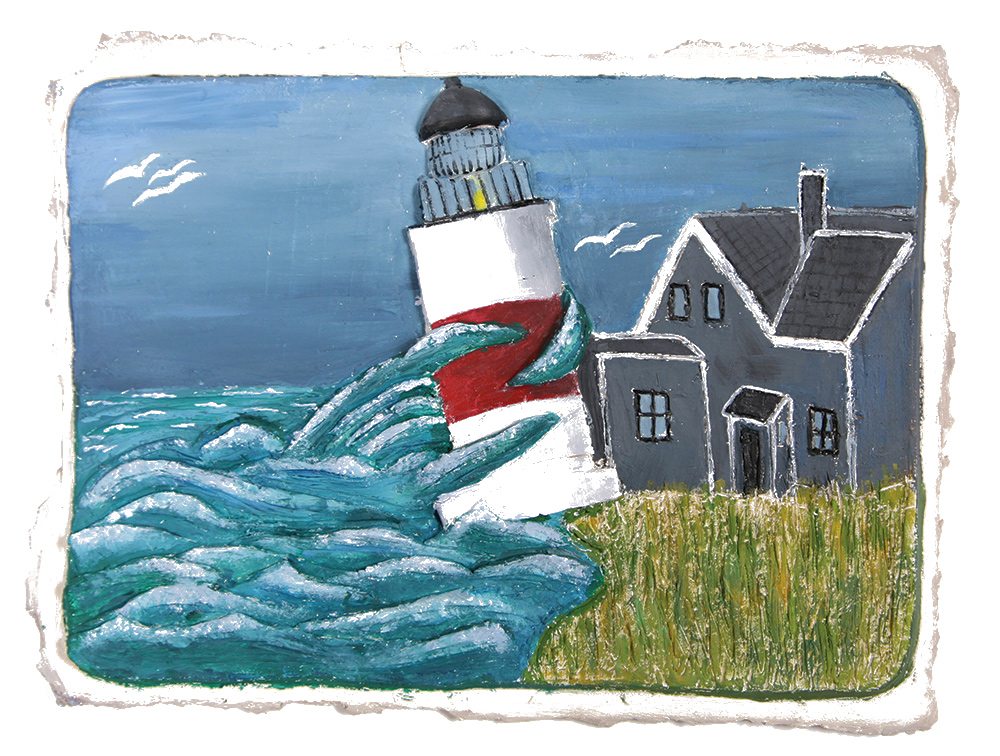
Painting by: Neva Callaghan
Today, all that remains of Billingsgate Island is an occasional sandbar a few miles off Wellfleet’s Jeremy Point. But that’s not to say Cape Cod’s ‘mini Atlantis’ has disappeared from the local consciousness. In this article, we look at the history of the island and the people who lived there and examine the efforts many have made to keep Billingsgate’s memory—and legend—alive.
When the Pilgrims arrived in the region in 1620, the town of Billingsgate (which at the time included Eastham and Wellfleet—and the 60-acre island) was home to the Punonakanit people—members of the Wampanoag Federation. In Of Plimoth Plantation, Mayflower scribe William Bradford describes the island as “a tongue of land, being flat, off from the shore, with a sandy point.” According to A History Of Billingsgate by Durand Echeverria, the Native Americans and the Europeans who settled in the Billingsgate community coexisted peacefully until smallpox eventually shrunk the Billingsgate Punonakanit population to just 11 in 1694.

Photo Courtesy of: The Wellfleet Historical Society
Originally settled by the Europeans as a fishing village, the island was most likely named after the famous Billingsgate fishing market of London. Over time, fishermen living in Wellfleet and Eastham brought their families onto the island where they would fish from early spring to the start of winter. These fishermen reeled in their catch using a variety of tools including gillnets, pounds, and weirs.
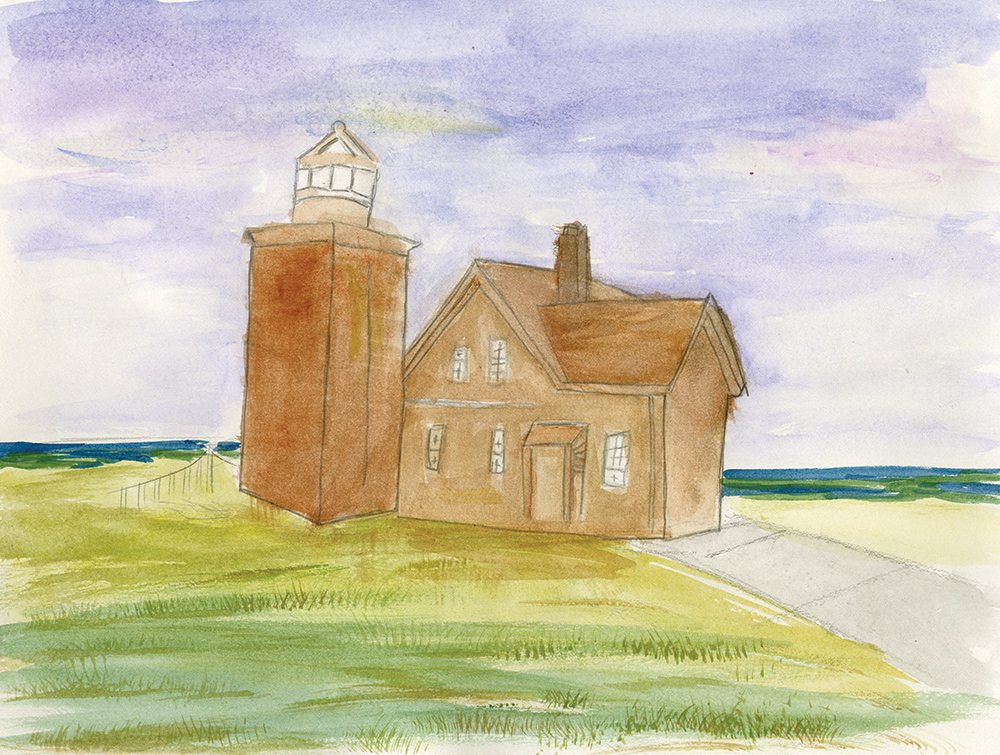
Painted by: Leslie Mayo
By 1850, Billingsgate held 30 homes, a school, a lighthouse, and a part-time population near 80. The lighthouse was the third to be built on Cape Cod at that time and served as a beacon for boaters traveling in Cape Cod Bay. In an article for Cape Cod Compass magazine in 1964, Wellfleet writer Clarence Daniels wrote that Billingsgate even had its own baseball team, and its members would row to the mainland to compete with other Outer Cape teams.
Billingsgate also acquired a reputation as rich territory for whaling, even sparking the pen of Henry David Thoreau to write stories about the island. In his writings about the Cape, Thoreau tells the true story of the lighthouse keeper of Billingsgate who stepped outside one day to find hundreds of blackfish—a smaller species of whale hunted in the 19th century—amassed on the island’s shores. Before anyone else realized what had happened, Herman Dill, the keeper, had initialed his name—a common practice of the time—on each of the washashores. Later that month, Dill sold the blackfish for a total of $1,000, earning more in that one day than he had ever made in a full year of work.
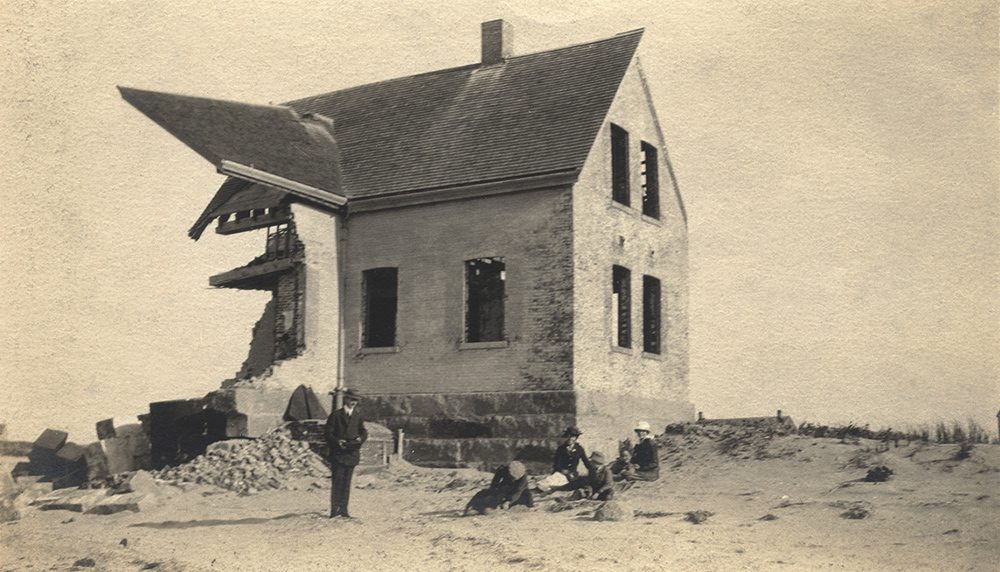
Photo Courtesy of: The Wellfleet Historical Society
While Billingsgate residents continued to build and expand, an unexpected storm devoured the island in 1855, cutting it nearly in half. With the lighthouse in harm’s way of the encroaching ocean, islanders built a new light on higher ground. In 1888, when wave patterns began to inspire frightening flashbacks of 1855, a seawall, 1,000 feet in length, was constructed to surround and protect the light. By that time, though, little could be done to prevent the island’s rapid erosion.
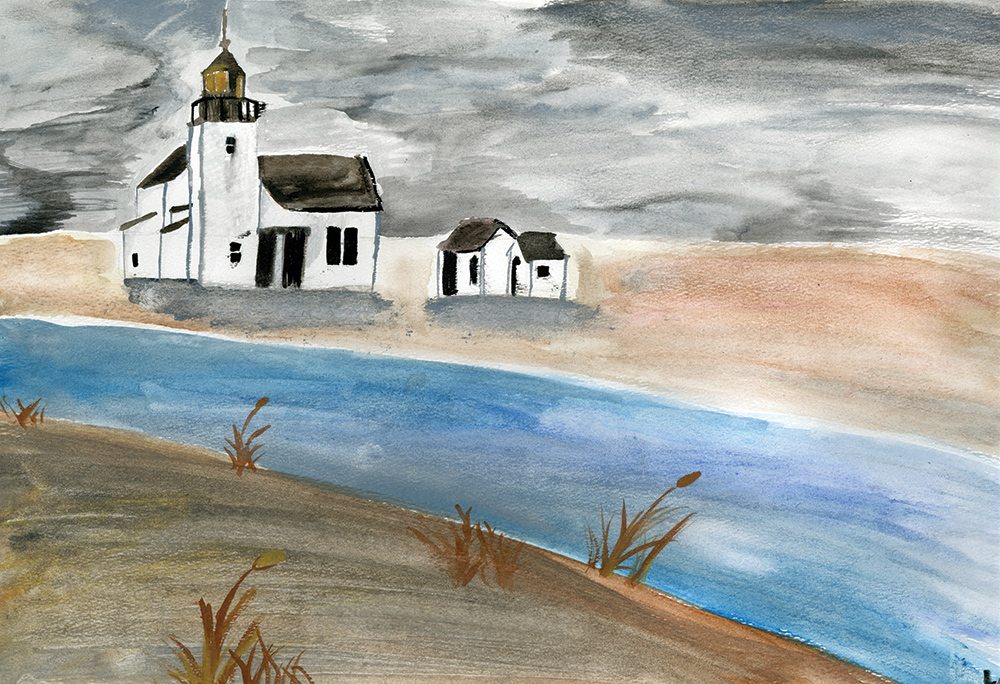
Painted by: Shelby Buchieri
With a seemingly predestined end, legends began to form among locals as to why Billingsgate was eroding so quickly. One legend comes from a Billingsgate man who had committed a capital crime on the island. As the executioner directed the man to the gallows in Wellfleet, legend has it the condemned man turned his head to the excited onlookers and proclaimed a curse on the village. “If I am hanged,” the man is alleged to have yelled, “the island of Billingsgate will be swallowed by the sea.”
And sure enough, it was. Recurring instances of the island’s engulfment by the waves led most Billingsgate inhabitants to depart for drier shores by 1905, often carrying or floating house structures to the mainland in hundreds of small pieces in a process known as “flaking.” Dwight Estey, a member of the Wellfleet Historical Society’s board of directors, described how this worked. “In this process, houses were cut in half—one was even cut in a zigzag pattern—and floated to the mainland to be reassembled after arriving on shore,” Estey says.
“The Billingsgate natives were thrifty people,” adds Joan Coughlin, the society’s curator. “They sold old brick and repurposed old house structures onto new homes built on the mainland. They believed that the island would rise back again someday.” Little did those islanders know that Billingsgate would indeed lose its battle with the ocean; in 1915, the lighthouse was washed away during a massive storm, and in 30 years’ time it was completely submerged beneath the waves.
Due to the initiative many islanders showed in recycling their homes on the mainland, many remains from island houses can be found throughout Wellfleet today; the materials literally piece together historic homes and walkways and help to preserve the island’s heritage and legacy.
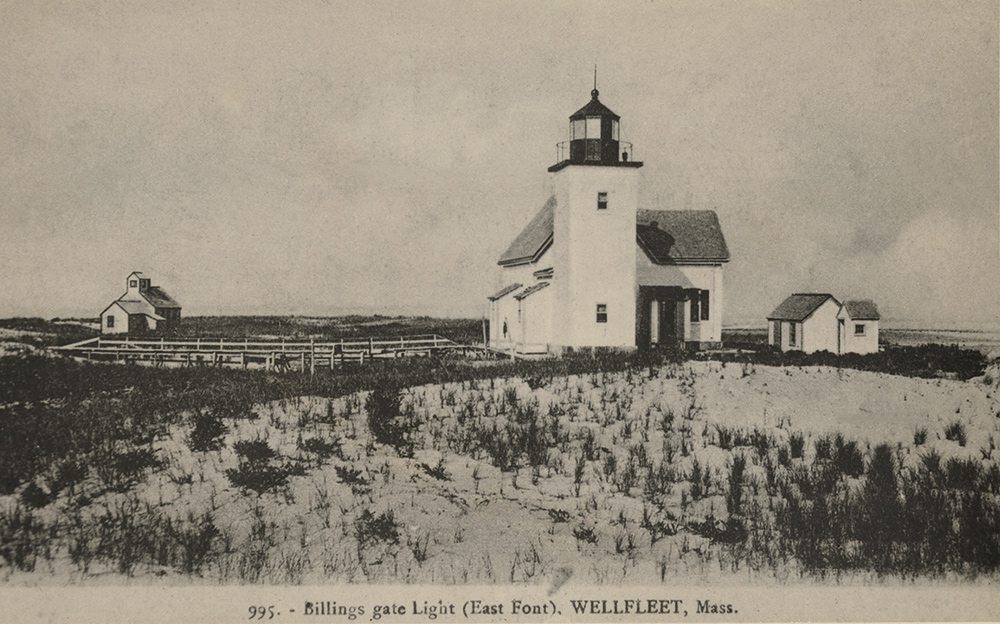
Photo Courtesy of: The Wellfleet Historical Society
Wellfleet business owners also proudly display the Billingsgate name around town. With an overnight stay at the Billingsgate Motel, or a freshly made Billingsgate Margarita at the Wellfleet Bookstore and Restaurant, the spirit of the island lingers. Also in Wellfleet, the Billingsgate Condominiums overlook Mayo Beach, and a collection of lovely cottages in nearby Dennis can be found on Billingsgate Way.
In addition, the Billingsgate Shoal still lives up to its generations’ old reputation as a prominent fishing area—particularly at low tide. “Aside from being entrenched in Cape Cod history, Billingsgate Shoal today offers fishermen plenty of phenomenal fishing opportunities for striped bass, bluefish, tuna, and even the occasional tautog,” says Ryan Collins, a Bourne resident who has been fishing Cape waters since he was 5 years old. “The shoal is a hub for recreational, charter, and commercial anglers,” Collins says. “Billingsgate is by far one of the top fishing areas on Cape Cod.”
In recent years, Billingsgate Shoal has also served as a rest stop for kayakers, and at extreme low tides, bricks from the foundation of the island’s lighthouse can be found.
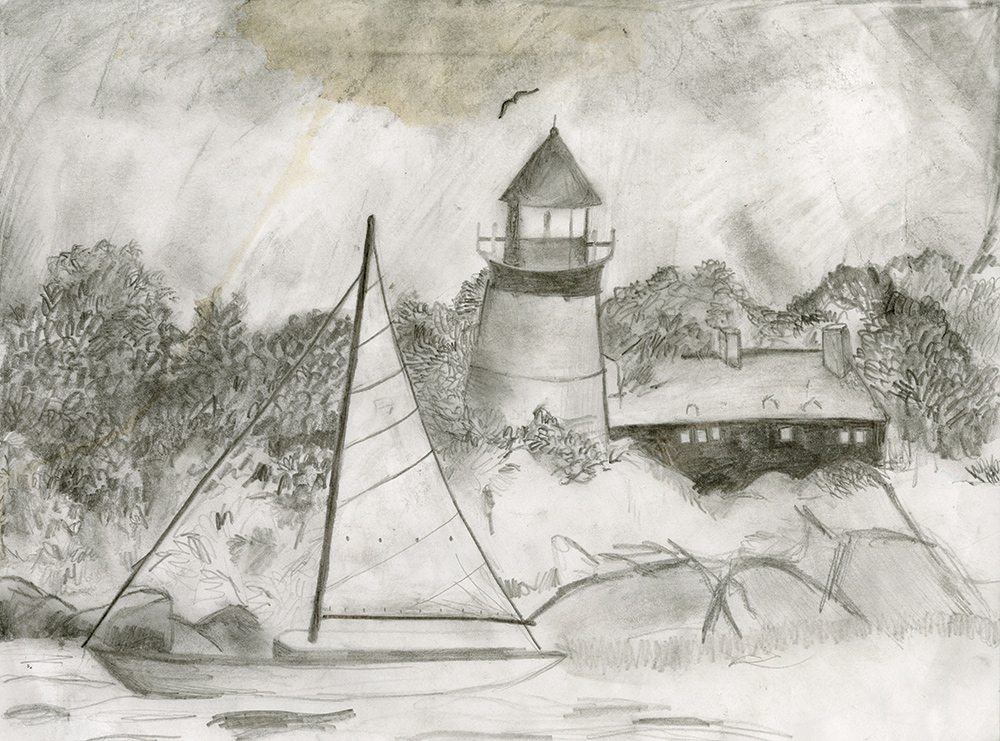
Photo by: Kristen Karlberg
Stories of Billingsgate’s rapid erosion—which occurred largely from 1855 to 1920—have stymied scientists for years, but the island’s disappearance beneath the water may portend the start of an environmental ripple effect in the region. “Without a doubt, the Cape and Islands will continue to erode because with or without sea-level rise, the loose sand of the glacial Cape has no resistance to wave attack,” writes Bob Oldale, a geologist at the Woods Hole Oceanographic Institute and the author of Cape Cod and the Islands: The Geologic Story. “Continued sea-level rise,” Oldale adds, “will accelerate the erosion and cause the demise of the Cape sooner, but it will take thousands of years before the Cape is reduced to shoals and low lying islands.”
Submerged since 1942, the state—or fate—of Billingsgate, may foreshadow, as Oldale says, a slow erosion and deterioration of Cape Cod to the point where one day, centuries hence, the peninsula will become its own Atlantis, appearing and disappearing in the tide, waiting to be unearthed and remembered. One thing, however, is certain: for the student of history, geology, and Cape Cod, the story of Billingsgate Island makes for a fascinating study.
Liam Russo is a senior at Barnstable High School.



